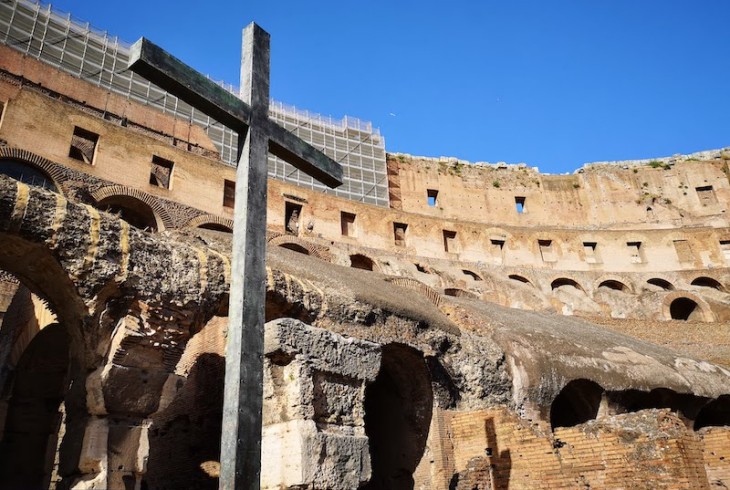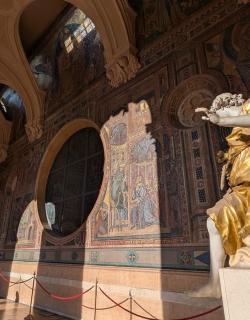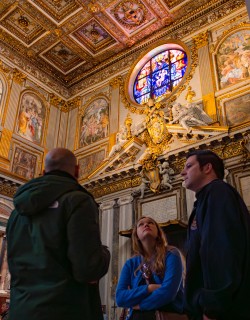Every Good Friday, as dusk falls over the Eternal City, the Colosseum is transformed into a dramatic stage for a fascinating Easter ritual. The Via Crucis, or Stations of the Cross, is among the most stirring liturgical events of the Catholic year in Rome, bringing pilgrims and onlookers together to relive Christ’s Passion in a place that has long been associated with martyrdom in the Christian tradition .
According to Christian tradition, Good Friday is the day on which Christ was crucified on Jerusalem's hill of Golgotha. To mark the occasion, each year the Pope leads a symbolic reenactment of Christ’s route to martyrdom in a torchlit procession that weaves its way from the Colosseum to the temple of Venus in the Roman Forum.
Discover the fascinating story of this Easter tradition with us, from its origins in 18th-century Rome through to the modern ceremony, and find out how to attend the Via Crucis in Rome! For more great things to do at Easter in Rome, check out our guide: What to Do in Rome at Easter.
What Are the Stations of the Cross?
The Stations of the Cross at San Bonaventura al Palatino
The Stations of the Cross - known as the Via Crucis in Italian - are a series of 14 devotional images that represent key events from the day of Jesus’ crucifixion, starting with his condemnation by Pontius Pilate and ending with his burial.
Rooted in Franciscan practices of devotion, this centuries-old tradition invites the faithful to follow in the footsteps of Christ’s final journey to Calvary, pausing at each “station” to reflect on his suffering and sacrifice. Each station along the route is marked by a specific scene, such as Jesus falling under the weight of the cross, meeting his mother, being helped by Veronica and Simon, or being nailed to the cross.
According to tradition Mary herself set up memorials at the various sites associated with her son’s martyrdom in Jerusalem after Christ’s crucifixion, and the so-called Via Dolorosa was an important devotional route for pilgrims to the city as far back as the Byzantine era.
The Stations of the Cross became popular in churches across Europe during the early-modern period as a way for Christians to make an imaginary spiritual pilgrimage to Jerusalem without leaving their home city. Today the practice is most often performed during Lent, especially on Good Friday itself - and no enactment is more important than the Via Crucis in Rome.
History of the Via Crucis at the Colosseum
The Christian dedicatory plaque of the Colosseum
In the late 16th and early 17th centuries, the by now well-established practice of retracing Christ’s Passion was formalized into the 14 stations of the cross that we recognize today. One of the key figures in the subsequent propagation of the ritual was the Genoese Franciscan preacher Leonardo da Porto Maurizio: a tireless missionary of remarkable zeal, Leonardo wrote that his mission was to “introduce this holy Exercise in all places,” and was responsible for the construction of over 570 Stations of the Cross all across Italy.
But his most ambitious vision was reserved for Rome, where he commissioned a series of Stations at the monastery of Saint Bonaventure on the Palatine Hill. You can still see these lovely painted terracotta sculptures depicting Christ’s Passion on the road leading up to the beautiful but overlooked church (where Leonardo himself is buried). Soon afterwards, Leonardo had his eyes on an even bigger prize.
In 1749, Fra Leonardo petitioned Pope Benedict XIV for permission to establish a permanent Via Crucis within the Colosseum itself. The Flavian amphitheatre had loomed large in the Christian imagination for centuries as a supposed site of martyrdom. In the 15th century, the Chapel of the Pietà had been built within its walls, whilst sacred passion plays were occasionally staged there during Easter week. Pope Clement X had officially consecrated the monument to the memory of Christ’s Passion in 1675.
Benedict XIV was on board with Leonardo’s Via Crucis plan, and on December 13, 1749, he authorized the construction of the Stations within the Colosseum as well as the founding of a new confraternity to manage the event. The Archconfraternity of the Lovers of Jesus and Mary on Calvary was formally established on December 17, 1750. Ten days later, the new Stations of the Cross and a large central cross were in place and blessed by the Pope, just in time for the Christmas celebrations during that Jubilee year .
From that point on, the faithful would gather regularly, especially during Holy Week, to walk the Via Crucis from the Via Sacra into the Colosseum, meditating on Christ’s suffering at the site where early Christians were believed to have been thrown to the lions. For over a century pilgrims wound their way along the via Sacra, entering the Colosseum to pray in the shadow of the cross.
The Decline and Revival of the Via Crucis in Rome
 One of the stations of the cross in the Colosseum
One of the stations of the cross in the Colosseum
With the unification of Italy in 1870 and the establishment of the new independent Italian state, papal processions ceased and the Colosseum’s sacred furnishings were dismantled. The cross was removed in 1874, and the rite fell into silence. It would be decades before the tradition was reborn. In 1926, amid the negotiations leading to the Lateran Treaty and the formation of the Vatican City, the cross was returned - this time to the side of the arena, where it still stands today.
Pope John XXIII revived the Via Crucis procession at the Colosseum in 1959, and it proved a smash hit. In 1964 Pope Paul VI leading the Via Crucis was beamed into homes across Europe by the broadcaster Eurovision, firmly establishing it as one of Rome’s most recognizable and unmissable sacred rituals. Since then, the tradition has become a fixture of Holy Week in the Eternal City.
How to Attend the Via Crucis in Person
The Via Crucis in full swing
Attending the Via Crucis at the Colosseum is one of the most atmospheric experiences of Holy Week in Rome, whether you are religious or not. The Via Crucis begins at twilight on Good Friday, typically around 9:15 PM. The Pope (although it is currently unclear whether Pope Francis’ health will allow him to attend this year) presides from a raised platform, crucifix in hand. A procession of torchbearers representing the global Church carries a wooden cross along the 14 stations, each accompanied by a reading, prayer, and meditation.
Here's everything you need to know if you'd like to attend yourself.
- Time & Place
The ceremony takes place on Good Friday evening, beginning at 9:15 PM. The procession usually starts near the Temple of Venus and Rome, just east of the Colosseum, and unfolds in view of the amphitheater’s arches, which are dramatically lit for the occasion.
- No Tickets Required
Unlike the Papal Mass on Easter Sunday in St. Peter’s Square, no reservation is needed to attend the Via Crucis. It’s one of the few major Vatican events where you can simply show up and take part. That said, space fills up fast, and Rome’s faithful turn out in large numbers - last year over 50,000 people attended the Via Crucis in person, so planning ahead to secure a good vantage point is all important.
- Where to Stand
For a clear view of the ceremony, aim for the Via dei Fori Imperiali, ideally the stretch closest to the Colosseum itself. From here, you’ll have a direct line of sight toward the illuminated arches and the area where the Pope and readers are stationed. Another good option is the Piazza del Colosseo, especially on the northern side near the Metro station, where large screens are often set up to broadcast the readings and reflections. One of our favorite vantage points is located above the Colosseum on the Colle Oppio hill (climb the steps by the Metro station to get here). This is typically less crowded, and the elevated position means you’ll get a great panoramic view of the events unfolding.
- When to Arrive
Early evening is best—ideally by 7:30 PM, or even earlier if you’re hoping for a front-row spot. As the sun sets, the crowds begin to gather, and security zones start to close off access points. Bring a bottle of water, a light jacket (Roman spring nights can be chilly), and patience for the wait. The mood, though solemn, is quietly communal—many people bring candles or prayer books, and the whole atmosphere becomes one of expectant reflection.
- Security & Entry
This is a high-profile event attended by the Pope, so security is tight. Police checkpoints are set up along all access routes to the Colosseum and the via Sacra. Expect bag checks, so avoid bringing bulky backpacks or items that might delay your entry. Be prepared too for road closures and changes to public transport in the area throughout the evening (the Colosseum metro station will be closed, as will nearby bus and tram stops).
Coming to Rome this Easter? There's no better time to visit the Eternal City than Spring! Through Eternity have been leading expert-led itineraries in Rome for over 25 years, so whatever you're interested in, we've got you covered! Check out our range of Rome tours here.
MORE GREAT CONTENT FROM THE BLOG:
- 5 of the Best Easter Foods in Italy
- The Best Things to Do in Rome this Easter
- Easter Traditions in Italy
- Florence's Fiery Easter Tradtion
- Pastiera: The Story of a Neapolitan Easter Classic
- How to Visit the Vatican in 2025
- A Pilgrim and Tourists Guide to Jubilee 2025




